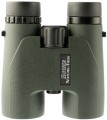Field of view 1 km away
The diameter of the area visible through binoculars / monoculars from a distance of 1 km — in other words, the largest distance between two points at which they can be seen simultaneously from this distance. It is also called "linear field of view". Along with the angular field of view (see below), this parameter characterizes the space covered by the optics; at the same time, it describes the capabilities of a particular model more clearly than data on viewing angles. Models with magnification adjustment (see above) usually indicate the maximum field of view — at the lowest magnification and
the widest angle of view. This information is often supplemented by data on the minimum value.
Real angle of view
The section of the panorama that can be viewed through the eyepieces of binoculars. The higher the actual angular field of view, the wider the visibility of the optics. Note that the angular field of view has an inverse relationship with magnification. That is, the higher the magnification, the narrower the visibility (the smaller the real angular field of view). The actual angular field of view is calculated as follows: you need to divide the angular field of view (in degrees °) by the magnification factor. In comparison, the human eye has an angular field of view of 60 arcseconds (“). In terms of degrees, you get 150 °. Good binoculars provide a real field of view somewhere within 10 arcseconds. But it does not always make sense to chase after large indicators of the real angular field of view. The fact is that when viewing a large section of the panorama, the edges of the image receive noticeable distortion.
Phase correction
The presence of a
phase correction system in binoculars / monoculars. This feature enhances image quality, such as resolution and colour reproduction, and minimizes colour distortion. The need to use phase correction is due to the fact that the light waves corresponding to different colours differ in length and penetrating power, which is why they also pass through the optical system in different ways. This may cause image quality degradation. To avoid this, special coatings are used in the prisms installed in the device — they retain the original ratio of colour waves and thus provide phase correction.
Eye relief
The offset is the distance between the eyepiece lens and the exit pupil of an optical instrument (see "Exit Pupil Diameter"). Optimum image quality is achieved when the exit pupil is projected directly into the observer's eye; so from a practical point of view, offset is the distance from the eye to the eyepiece lens that provides the best visibility and does not darken the edges (vignetting). A large offset is especially important if the binoculars / monoculars are planned to be used simultaneously with glasses — because in such cases it is not possible to bring the eyepiece close to the eye.
Prism material
Material used for prisms found in binoculars and monoculars.
-
BK-7. A type of borosilicate optical glass (6LR61), a relatively inexpensive and at the same time quite functional material that provides, although not outstanding, quite acceptable image quality. Used in entry-level and mid-level models.
—BaK-4. Barium optical glass, noticeably superior to BK7 in brightness and image clarity, is however also more expensive. Accordingly, it is found mainly in the premium segment.
Tripod adapter
The presence in the design of the binoculars / monocular
socket for attaching an adapter for a tripod(the adapter itself is not included in the kit, unless otherwise indicated). This feature is especially important for high magnification models (see above): they are usually heavy, making it difficult to hold stable in your hands, and at high magnification, even slight shaking can make observation impossible. In addition, mounting on a tripod is convenient for constant observation of a certain place, and such observation does not always require high magnification. Therefore, even fairly small devices can have the possibility of attaching an adapter. The adapters themselves can be designed for different sizes of tripod mounts — this must be taken into account when choosing such a model.

